








生物技术通报 ›› 2025, Vol. 41 ›› Issue (1): 230-239.doi: 10.13560/j.cnki.biotech.bull.1985.2024-0451
袁柳娇1( ), 黄文琳1, 陈崇志2, 梁敏3, 黄梓淇1, 陈雪雪1, 陈日檬3(
), 黄文琳1, 陈崇志2, 梁敏3, 黄梓淇1, 陈雪雪1, 陈日檬3( ), 王锂韫1(
), 王锂韫1( )
)
收稿日期:2024-05-15
出版日期:2025-01-26
发布日期:2025-01-22
通讯作者:
王锂韫,女,博士,研究方向:植物学;E-mail: wly@lingnan.edu.cn;作者简介:袁柳娇,女,硕士,研究方向:植物学;E-mail: liujiaoy@126.com
基金资助:
YUAN Liu-jiao1( ), HUANG Wen-lin1, CHEN Chong-zhi2, LIANG Min3, HUANG Zi-qi1, CHEN Xue-xue1, CHEN Ri-Meng3(
), HUANG Wen-lin1, CHEN Chong-zhi2, LIANG Min3, HUANG Zi-qi1, CHEN Xue-xue1, CHEN Ri-Meng3( ), WANG Li-yun1(
), WANG Li-yun1( )
)
Received:2024-05-15
Published:2025-01-26
Online:2025-01-22
摘要:
【目的】探究盐胁迫处理对广藿香幼苗叶片生理特性、超微结构及药效成分含量的影响,为广藿香人工栽培和抗逆种质筛选及培育高产、优质、高抗的品种提供参考。【方法】以‘石牌’广藿香幼苗为材料进行盆栽试验,采用浓度为0(CK)、50(低浓度)、100(中浓度)、150(中高浓度)、200(高浓度)mmol/L的氯化钠(NaCl)溶液进行处理。于胁迫后10、15和20 d,分别采取广藿香幼苗叶片进行抗氧化酶活性、丙二醛含量测定,并测量株高及拍照记录生长情况;于胁迫后20 d,观察叶片细胞结构变化,及测定广藿香百秋李醇和广藿香酮含量。【结果】随着盐胁迫浓度增加与胁迫时间的推移,广藿香幼苗增长速率逐渐降低,高浓度盐胁迫下幼苗出现萎蔫或枯死现象。盐胁迫处理10 d时,与CK组相比,不同浓度处理组的过氧化物酶(peroxidase, POD)、过氧化氢酶(catalase, CAT)活性及丙二醛(malondialdehyde, MDA)含量均升高。除高浓度处理组外,其他胁迫处理组幼苗超氧化歧化酶(superoxide dismutase, SOD)活性升高;处理20 d时,百秋李醇和广藿香酮含量均呈上升趋势,且高浓度处理组药效成分含量均较对照组高。高浓度的盐胁迫对广藿香叶片细胞结构造成损伤,叶绿体降解呈离散状态,类囊体基质片层微曲、间距加大;线粒体嵴膨大,部分出现半空泡化现象;波浪状的细胞质膜从细胞壁缩回,部分细胞发生质壁分离。【结论】盐胁迫下广藿香幼苗抗氧化酶活性显著提高,能够清除多余的活性氧以抵御胁迫环境,并促进了百秋李醇和广藿香酮2种有效成分的合成,以保证植株生长,提高了药材的品质。因此认为广藿香在一定程度上能够适应盐渍化土壤。
袁柳娇, 黄文琳, 陈崇志, 梁敏, 黄梓淇, 陈雪雪, 陈日檬, 王锂韫. 盐胁迫对广藿香叶片生理特性、超微结构及药效成分的影响[J]. 生物技术通报, 2025, 41(1): 230-239.
YUAN Liu-jiao, HUANG Wen-lin, CHEN Chong-zhi, LIANG Min, HUANG Zi-qi, CHEN Xue-xue, CHEN Ri-Meng, WANG Li-yun. Effects of Salt Stress on Physiological Characteristics, Ultrastructure and Medicinal Components of Pogostemon cablin Leaves[J]. Biotechnology Bulletin, 2025, 41(1): 230-239.

图1 不同浓度盐胁迫对广藿香幼苗生长的影响 A-E:盐胁迫下广藿香幼苗第10天的生长情况;F-J:盐胁迫下广藿香幼苗第15天的生长情况;K-O:盐胁迫下广藿香幼苗第20天的生长情况
Fig. 1 Effects of different concentrations of NaCl stress on the growth of P. cablin seedlings A-E: The growth of P. cablin seedlings on day 10 under salt stress; F-J: the growth of P. cablin seedlings on day 15 under salt stress; K-O: the growth of P. cablin seedlings on day 20 under salt stress
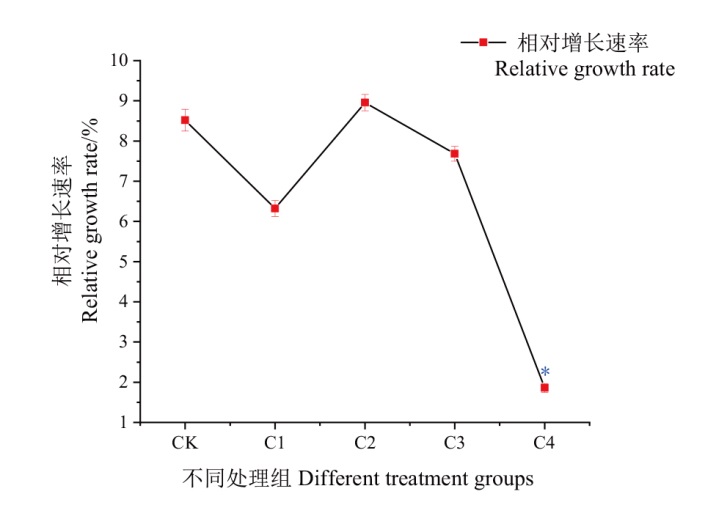
图2 不同浓度盐胁迫对广藿香幼苗相对增长率的影响 *表示与不同组间有显著性差异(P<0.05);下同
Fig. 2 Effects of different concentrations of NaCl stress on the relative growth rate of P. cablin seedlings * indicate that there is a significant difference among different groups(P<0.05). The same below
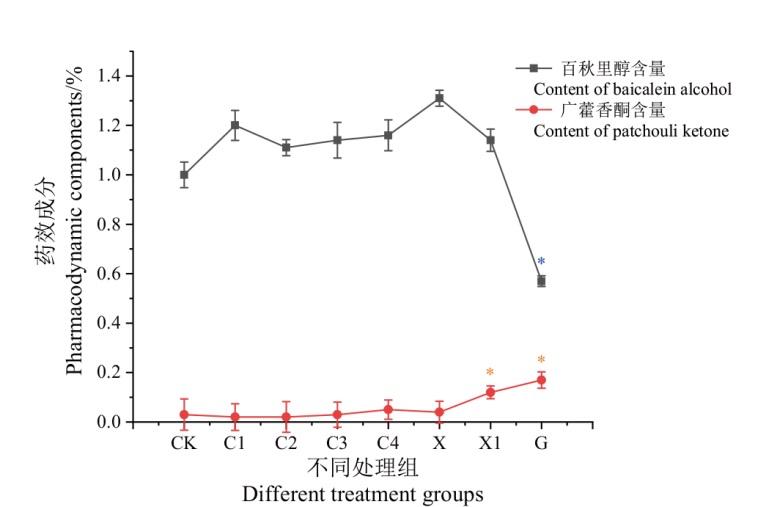
图3 盐胁迫20 d不同处理组广藿香幼苗药效成分的变化 X、X1、G分别表示采集种植于田间的‘石牌’广藿香鲜叶、鲜地上部分、干地上部分
Fig. 3 Changes of pharmacodynamic components of P. cablin seedlings in different treatment groups after 20 d of NaCl stress X, X1 and G in different treatment groups indicate the fresh leaves, fresh aboveground parts and dry aboveground parts of ‘Shipai’ P. cablin collected and planted in the field, respectively
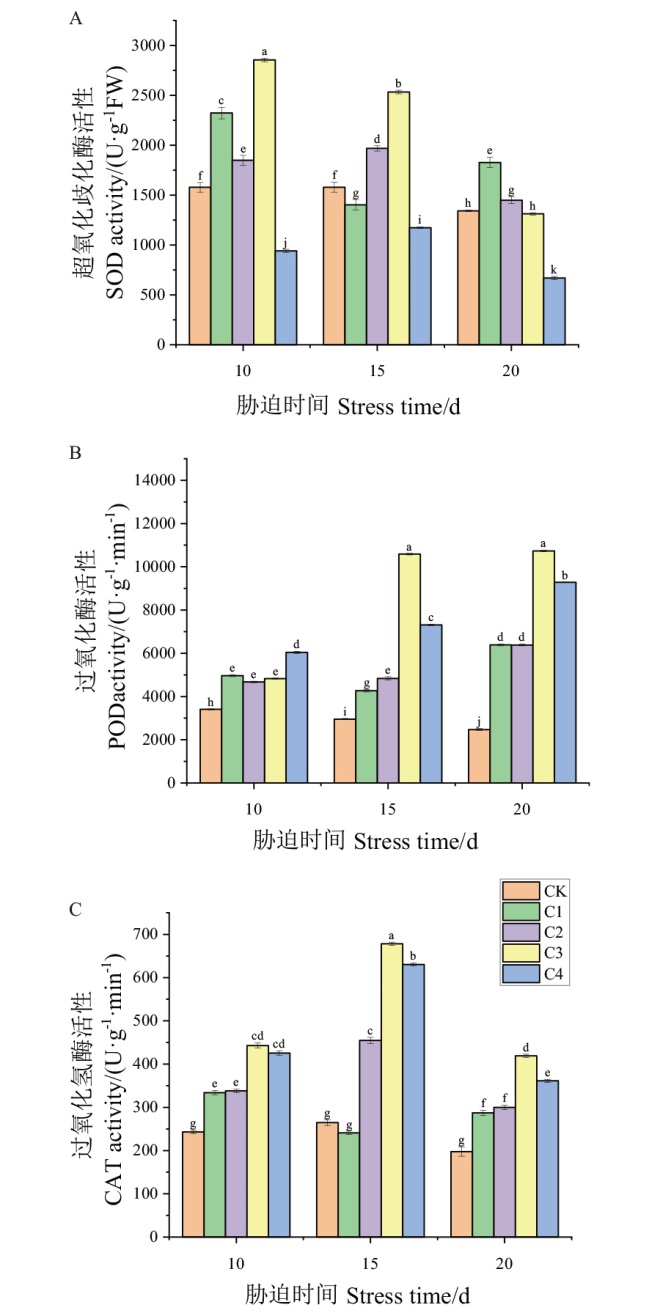
图4 不同浓度NaCl处理对广藿香叶片抗氧化酶活性的影响 不同小写字母表示组间有显著差异(P<0.05);下同
Fig. 4 Effects of different concentrations of NaCl stress on antioxidant enzyme activities in P. cablin leaves Different lowercase letters indicated significant differences between groups(P < 0.05). The same below
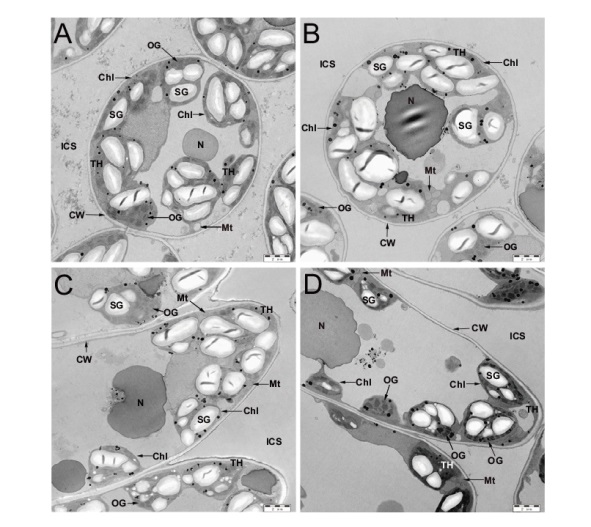
图6 不同浓度盐胁迫下广藿香叶肉细胞超微结构的变化 A:对照组(CK)(8 000×);B:C1组(8 000×);C:C2组(8 000×);D:C4组(8 000×)。Chl:叶绿体;CW:细胞壁;N:细胞核;Mt:线粒体;SG:淀粉粒;ICS:细胞间隙;TH:类囊体基质;OG:嗜锇颗粒;下同
Fig. 6 Ultrastructural changes of mesophyll cells of P. ca-blin under different concentrations of NaCl stress A: Control group(CK)(8 000×); B: C1 group(8 000×); C: C2 group(8 000×); D: C4 group(8 000×). Chl: Chloroplasts; CW: cell wall;N: nucleus; Mt: mitochondria; SG: starch granules; ICS: intercellular space;TH: thylakoid matrix; OG: osmiophilic granules. The same below
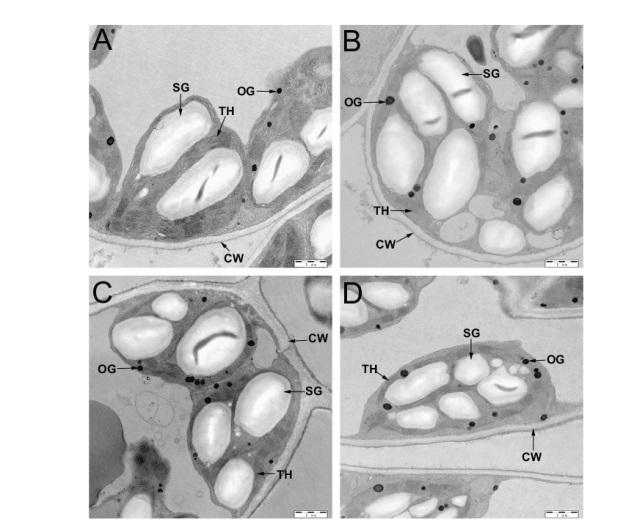
图7 不同浓度盐胁迫下广藿香叶片叶绿体形态和分布的变化 A:对照组(CK)(20 000×);B:C1组(20 000×);C:C2组(20 000×);D:C4组(20 000×),下同
Fig. 7 Changes of chloroplast morphology and distribution in the leaves of P. cablin under different concentrations of NaCl stress A: Control group(CK)(20 000×); B: C1 group(20 000×); C: C2 group(20 000×); D: C4 group(20 000×), the same below
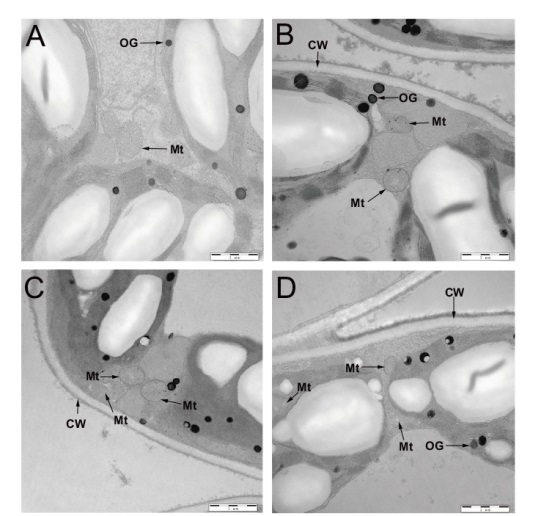
图8 不同浓度盐胁迫下广藿香叶片线粒体形态和分布的变化
Fig. 8 Changes of particle morphology and distribution in the leaves of P. cablin under different concentrations of NaCl stress
| [1] | Yang HC, Chen Y, Zhang FH. Evaluation of comprehensive improvement for mild and moderate soil salinization in arid zone[J]. PLoS One, 2019, 14(11): e0224790. |
| [2] | Mirzavand M, Sadeghi S, Bagheri R. Groundwater and soil salinization and geochemical evolution of Femenin-Ghahavand Plain, Iran[J]. Environ Sci Pollut Res Int, 2020, 27(34): 43056-43066. |
| [3] |
Maurya S, Abraham JS, Somasundaram S, et al. Indicators for assessment of soil quality: a mini-review[J]. Environ Monit Assess, 2020, 192(9): 604.
doi: 10.1007/s10661-020-08556-z pmid: 32857216 |
| [4] | Said I, Salman SA, Elnazer AA. Salinization of groundwater during 20 years of agricultural irrigation, Luxor, Egypt[J]. Environ Geochem Health, 2022, 44(11): 3821-3835. |
| [5] | 余贝, 武志海, 符冠富. 盐胁迫影响水稻生理特性及其调控机理研究进展[J]. 作物研究, 2023, 37(2): 189-198. |
| Yu B, Wu ZH, Fu GF. Advanced on salt stress affecting rice plants growth development and its regulating mechanisms[J]. Crop Res, 2023, 37(2): 189-198. | |
| [6] | 徐宠然, 赵鑫, 贾袭伟, 等. 半夏对盐胁迫的生理生化响应及耐盐机理研究[J]. 中药材, 2023, 46(7): 1617-1623. |
| Xu CR, Zhao X, Jia XW, et al. Physiological and biochemical responses of Pinellia ternata to salt stress and its salt tolerance mechanism[J]. J Chin Med Mater, 2023, 46(7): 1617-1623. | |
| [7] | Wang SC, Fang D, Ameen A, et al. Dynamics of spring regrowth and comparative production performance of 50 autumn-sown alfalfa cultivars in the coastal saline soil of North China[J]. Life, 2021, 11(12): 1436. |
| [8] | Wang LL, Sun XY, Li SY, et al. Application of organic amendments to a coastal saline soil in North China: effects on soil physical and chemical properties and tree growth[J]. PLoS One, 2014, 9(2): e89185. |
| [9] |
Thiam S, Villamor GB, Faye LC, et al. Monitoring land use and soil salinity changes in coastal landscape: a case study from Senegal[J]. Environ Monit Assess, 2021, 193(5): 259.
doi: 10.1007/s10661-021-08958-7 pmid: 33837853 |
| [10] |
Kaushal M. Insights into microbially induced salt tolerance and endurance mechanisms(STEM)in plants[J]. Front Microbiol, 2020, 11: 1518.
doi: 10.3389/fmicb.2020.01518 pmid: 32982994 |
| [11] | 信龙飞, 孙万慧, 刘红云, 等. 盐胁迫对栝楼幼苗生长和生理特性的影响[J]. 北方园艺, 2023(14): 125-132. |
| Xin LF, Sun WH, Liu HY, et al. Effects of salt stress on growth and physiological characteristics of Trichosanthes kirilowii Maxim. Seedlings[J]. North Hortic, 2023(14): 125-132. | |
| [12] | 牛灵慧. 丹参生物学特性及盐胁迫对其次生代谢影响研究[D]. 南京: 南京农业大学, 2016. |
| Niu LH. study on biological characteristics of salvia miltiorrhiza[D]. Nanjing: Nanjing Agricultural University, 2016. | |
| [13] | Tran DQ, Pham AC, Nguyen TTT, et al. Growth, physiological, and biochemical responses of a medicinal plant Launaea sarmentosa to salinity[J]. Horticlturae, 2024, 10(4): 388. |
| [14] | Barwal SK, Shah SH, Pawar A, et al. Mechanistic insights of salicylic acid-mediated salt stress tolerance in Zea mays L. seedlings[J]. Heliyon, 2024, 10(14): e34486. |
| [15] | Birhanie ZM, Yang DW, Luan MB, et al. Salt stress induces changes in physiological characteristics, bioactive constituents, and antioxidants in kenaf(Hibiscus cannabinus L.)[J]. Antioxidants, 2022, 11(10): 2005. |
| [16] | Zhu Y, Gu W, Tian R, et al. Morphological, physiological, and secondary metabolic responses of Taraxacum officinale to salt stress[J]. Plant Physiol Biochem, 2022, 189: 71-82. |
| [17] | 荆文光, 李楚, 赵小亮, 等. 广藿香和土藿香研究现状及相关建议[J]. 中国现代中药, 2023, 25(6): 1342-1349. |
| Jing WG, Li C, Zhao XL, et al. Research status of pogostemonis herba(Guanghuoxiang)and agastachis herba(Tuhuoxiang)and recommendations[J]. Mod Chin Med, 2023, 25(6): 1342-1349. | |
| [18] |
顾艳, 梅瑜, 徐世强, 等. 广藿香种质资源及栽培技术研究进展[J]. 热带作物学报, 2022, 43(8): 1595-1603.
doi: 10.3969/j.issn.1000-2561.2022.08.008 |
| Gu Y, Mei Y, Xu SQ, et al. Research progress on germplasm resources and cultivation techniques of Pogostemon cablin[J]. Chin J Trop Crops, 2022, 43(8): 1595-1603. | |
| [19] | 陈运雷, 罗昌优, 罗静, 等. 人工栽培下三种药用植物生理适应性研究[J]. 热带林业, 2021, 49(4): 36-38, 25. |
| Chen YL, Luo CY, Luo J, et al. Study on physiological adaptability of three medicinal plants under artificial cultivation[J]. Trop For, 2021, 49(4): 36-38, 25. | |
| [20] | 于志民, 吕品, 王立民, 等. 我国东北地区中药材生态复合种植现状与发展潜力分析[J]. 中药材, 2024,(5): 1071-1078. |
| Yu ZM, Lu P, Wang LM. Analysis on current situation and development potential of ecological compound planting of Chinese medicinal materials in northeast China[J]. J Chin Med Mater. 2024,(5): 1071-1078. | |
| [21] | 顾旭鹏, 杨林林, 董诚明, 等. 中药材品质形成机制及调控研究进展[J]. 北方园艺, 2024,(6): 129-137. |
| Gu XP, Yang LL, Dong CM, et al. Research progress on quality formation mechanism and regulation of Chinese herbal materials[J]. North Hortic, 2024(6): 129-137. | |
| [22] | 张雪佳, 巫兴东, 汪哲, 等. 中国西部茜草属药用植物资源调查、分类鉴定与开发利用[J]. 时珍国医国药, 2023, 34(11): 2755-2760. |
| Zhang XJ, Wu XD, Wang Z, et al. Investigation, classification, identification, development and utilization of Rubia medicinal plant resources in western China[J]. Lishizhen Med Mater Med Res, 2023, 34(11): 2755-2760. | |
| [23] | 刘娟, 李琛, 张勇洪, 等. 中药资源再生的研究进展与发展战略思考[J]. 中国科学:生命科学, 2023, 53(9): 1274-1286. |
| Liu J, Li C, Zhang YH, et al. Research progress and development strategy of Chinese medicine resource regeneration[J]. Chin sci: life sci, 2023, 53(9): 1274-1286. | |
| [24] | 李贤超, 吴友根, 杨东梅, 等. 海南广藿香叶肉细胞超微结构对盐胁迫的响应[J]. 江西农业大学学报, 2014, 36(2): 300-304. |
| Li XC, Wu YG, Yang DM, et al. Respond of salt stress on ultrastructure of mesophyll cells in Pogostemon cablin[J]. Acta Agric Univ Jiangxiensis, 2014, 36(2): 300-304. | |
| [25] | 郭巧生, 吴友根, 林尤奋, 等. 广藿香幼苗期生长及其抗氧化酶活性对盐胁迫的响应[J]. 中国中药杂志, 2009, 34(5): 530-534. |
| Guo QS, Wu YG, Lin YF, et al. Effect of NaCl stress on growth and antioxidant systems of Pogostemon cablin[J]. China J Chin Mater Med, 2009, 34(5): 530-534. | |
| [26] | 江绪文, 李贺勤. 外源水杨酸对盐胁迫下广藿香种子萌发和幼苗生长的影响[J]. 中草药, 2015, 46(15): 2303-2308. |
| Jiang XW, Li HQ. Effects of exogenous salicylic acid on seed germination and seedling growth of Pogostemon cablin under salt stress[J]. Acupunct Res, 2015, 46(15): 2303-2308. | |
| [27] | 国家药典委员会. 中华人民共和国药典[S]. 北京: 中国医药科技出版社, 2020: 46-47. |
| National Pharmacopoeia Commission. Pharmacopoeia of the People's Republic of China[S]. Beijing: China Medicine Science Press, 2020: 46-47. | |
| [28] | 行冰楠, 吴文如, 邹何元, 等. 广藿香《中国药典》药材质量标准与国际市场等标准的对比分析[J]. 中国民族民间医药, 2023, 32(6): 31-38. |
| Xing BN, Wu WR, Zou HY, et al. Comparative analysis of quality standards of Pogostemon cabli‘Chinese Pharmacopoeia’ and international market standards[J]. Chin Folk Med, 2023, 32(6): 31-38. | |
| [29] | 孙婕妤. 镉胁迫对不同地被菊品种生理特性及超微结构的影响[D]. 哈尔滨: 东北林业大学, 2018. |
| Sun JY. Effects of cadmium stress on physiological characteristics and ultrastructure of different ground-cover chrysanthemum varieties[D]. Harbin: Northeast Forestry University, 2018. | |
| [30] | 吴春杏, 胡志辉, 鲁寒英, 等. EBR对盐胁迫下玉米幼苗光合及抗氧化系统的影响[J]. 江苏农业科学, 2023, 51(13): 109-116. |
| Wu CX, Hu ZH, Lu HY, et al. Effects of EBR on photosynthesis and antioxidant system of maize seedlings under salt stress[J]. Jiangsu Agric Sci, 2023, 51(13): 109-116. | |
| [31] | 孙凤岭, 陈昆, 姜涛. 盐胁迫对西瓜幼苗生物量及生理特性的影响[J]. 现代农业科技, 2023(7): 63-65. |
| Sun FL, Chen K, Jiang T. Effects of salt stress on biomass and physiological characteristics of watermelon seedlings[J]. Mod Agric Sci Technol, 2023(7): 63-65. | |
| [32] | Zhao SS, Zhang QK, Liu MY, et al. Regulation of plant responses to NaCl stress[J]. Int J Mol Sci, 2021, 22(9): 4609. |
| [33] | 鲁克嵩, 闫磊, 侯佳玉, 等. 盐胁迫下外源脯氨酸对油菜Na+/K+平衡、生长及抗氧化系统的影响[J]. 华中农业大学学报, 2023, 42(5): 1-8. |
| Lu KS, Yan L, Hou JY, et al. Effects of exogenous proline on Na+/K+ balance, growth and antioxidant system of rape under salt stress[J]. J Huazhong Agric Univ, 2023, 42(5): 1-8. | |
| [34] | 姚侠妹, 纪敬, 岳剑云, 等. ABA对盐胁迫下侧柏ROS代谢及其相关基因表达的研究[J]. 西北植物学报, 2017, 37(1): 105-114. |
| Yao XM, Ji J, Yue JY. Reactive oxygen metabolism and related gene expression in Platycladus orientalis under salt stress[J]. Acta Bot Boreal-Occident Sin, 2017, 37(1): 105-114. | |
| [35] | 周春艳, 狄永国, 仇全雷, 等. 转录组和代谢组联合分析低温胁迫对天麻生长发育的影响[J]. 分子植物育种, 2021, 21(1): 110-122. |
| Zhou CY, Di YG, Qiu QL, et al. Transcriptome and metabolome combined analysis of the effects of low temperature stress on the growth and development of Gastrodia elata[J]. Mol Plant Breeding, 2021, 21(1): 110-122. | |
| [36] | 吴鑫, 王琳, 龙应霞. 镉胁迫对不同水稻幼苗生长和叶片生理活性的影响[J]. 农业与技术, 2023, 43(14): 43-46. |
| Wu X, Wang L, Long YX. Effects of cadmium stress on the growth of different rice seedlings and physiological activities of leaves[J]. Agric Technol, 2023, 43(14): 43-46. | |
| [37] |
谷俊, 耿贵, 李冬雪, 等. 盐胁迫对植物各营养器官形态结构影响的研究进展[J]. 中国农学通报, 2017, 33(24): 62-67.
doi: 10.11924/j.issn.1000-6850.casb17050110 |
| Gu J, Geng G, Li DX, et al. Effect of salt stress on plant nutritional organs’ morphology and structure: research progress[J]. Chin Agric Sci Bull, 2017, 33(24): 62-67. | |
| [38] | 王凯鑫, 杜利霞. Na2CO3胁迫对赖草叶片光合、叶绿素荧光、超微结构的影响[J]. 山西农业科学, 2024, 52(1): 86-93. |
| Wang KX, Du LX. Effects of Na2CO3 stress on photosynthesis, chlorophyll fluorescence and ultrastructure of Leymus secalinus leaves[J]. J Shanxi Agric Sci, 2024, 52(1): 86-93. | |
| [39] | 郑文菊, 王勋陵, 沈禹颖. 几种盐地生植物同化器官的超微结构研究[J]. 电子显微学报, 1999, 18(5): 507-512. |
| Zheng WJ, Wang XL, Shen YY. A study on the ultrastructure of assimilative organs of some plants in saline habitate[J]. J Chin Electron Microsc Soc, 1999, 18(5): 507-512. | |
| [40] | Shi WG, Li JY, Xie SY, et al. Selection of the dominant endophytes based on illumina sequencing analysis for controlling bacterial wilt of patchouli caused by ralstonia solanacearum[J]. Plant Dis, 2024, 108(4): 996-1004. |
| [41] | Singh S, Agrawal N. Exploring the pharmacological potential and bioactive components of Pogostemon cablin(Blanco)Benth, traditional Chinese medicine[J]. Pharmacol Res Mod Chin Med, 2024, 10: 100382. |
| [42] | Wu ZN, Zeng HR, Zhang LL, et al. Correction to: patchouli alcohol: a natural sesquiterpene against both inflammation and intestinal barrier damage of ulcerative colitis[J]. Inflammation, 2024, 47(2): 837-838. |
| [43] | 苏琦, 张珂, 黄淑琪, 等. 逆境胁迫对药用植物药效成分积累的影响[J]. 湖北民族大学学报:自然科学版, 2022, 40(2): 129-134, 180. |
| Su Q, Zhang K, Huang SQ, et al. Effects of adversity stress on accumulation of medical components in plants[J]. J Hubei Minzu Univ Nat Sci Ed, 2022, 40(2): 129-134, 180. | |
| [44] | 宋方帅. 盐胁迫对连钱草药效成分累积影响的研究[D]. 湖北民族大学, 2020. |
| Song FS. Study on the effect of salt stress on the accumulation of medicinal components in Glechoma[D]. Hubei Minzu Univ, 2020. | |
| [45] |
Rezaie R, Abdollahi Mandoulakani B, Fattahi M. Cold stress changes antioxidant defense system, phenylpropanoid contents and expression of genes involved in their biosynthesis in Ocimum basilicum L.[J]. Sci Rep, 2020, 10(1): 5290.
doi: 10.1038/s41598-020-62090-z pmid: 32210286 |
| [46] | Salinitro M, Hoogerwerf S, Casolari S, et al. Production of antioxidant molecules in Polygonum aviculare(L.)and Senecio vulgaris(L.)under metal stress: a possible tool in the evaluation of plant metal tolerance[J]. Int J Mol Sci, 2020, 21(19): 7317. |
| [47] | Abbas M, Sharif S, Baig IS, et al. Biochemical stress markers, antioxidants, and infectious wound-healing potential of UV irradiation and salt stress effects on the pre-treated seed of bitter melon(Momordica charantia L.)[J]. Dose Response, 2021, 19(4): 15593258211044062. |
| [48] | Zhang MZ, Yu ZM, Zeng DQ, et al. Transcriptome and metabolome reveal salt-stress responses of leaf tissues from Dendrobium officinale[J]. Biomolecules, 2021, 11(5): 736. |
| [49] | Sharma A, Shahzad B, Rehman A, et al. Response of phenylpropanoid pathway and the role of polyphenols in plants under abiotic stress[J]. Molecules, 2019, 24(13): 2452. |
| [50] | 李江楠, 尤健, 蒋章, 等. 盐碱胁迫对药用植物羊蹄三种药用成分的影响[J]. 特产研究, 2022, 44(1): 8-14. |
| Li JN, You J, Jiang Z, et al. Effects of saline-alkali stress on three medicinal component of the medicinal plant Rumex japonica[J]. Spec Wild Econ Anim Plant Res, 2022, 44(1): 8-14. |
| [1] | 李彩霞, 李艺, 穆宏秀, 林俊轩, 白龙强, 孙美华, 苗妍秀. 中国南瓜bHLH转录因子家族的鉴定与生物信息学分析[J]. 生物技术通报, 2025, 41(1): 186-197. |
| [2] | 武帅, 辛燕妮, 买春海, 穆晓娅, 王敏, 岳爱琴, 赵晋忠, 吴慎杰, 杜维俊, 王利祥. 大豆GS基因家族全基因组鉴定及胁迫响应分析[J]. 生物技术通报, 2024, 40(8): 63-73. |
| [3] | 李景艳, 周家婧, 袁媛, 苏晓艺, 乔文慧, 薛岩磊, 李国婧, 王瑞刚. 拟南芥AtiPGAM2基因参与非生物胁迫的响应[J]. 生物技术通报, 2024, 40(5): 215-224. |
| [4] | 李慧, 文钰芳, 王悦, 纪超, 石国优, 罗英, 周勇, 李志敏, 吴晓玉, 杨有新, 刘建萍. 盐胁迫下辣椒CaPIF4的表达特性与功能分析[J]. 生物技术通报, 2024, 40(4): 148-158. |
| [5] | 高玉坤, 张建东, 杨溥原, 陈东明, 王志博, 田颐瑾, Zakey Eldinn.E.A.Khlid, 崔江慧, 常金华. 高粱根际土壤细菌群落对盐胁迫的响应[J]. 生物技术通报, 2024, 40(4): 203-216. |
| [6] | 高志伟, 魏明, 于祖隆, 伍国强, 魏俊龙. 耐盐植物促生菌W-1鉴定及其对红豆草耐盐性的影响[J]. 生物技术通报, 2024, 40(4): 217-227. |
| [7] | 沈天虹, 齐孝博, 赵瑞丰, 马欣荣. 微藻盐胁迫响应分子机制研究进展[J]. 生物技术通报, 2024, 40(3): 89-99. |
| [8] | 李昊, 伍国强, 魏明, 韩悦欣. 甜菜BvBADH基因家族全基因组鉴定及其高盐胁迫下的表达分析[J]. 生物技术通报, 2024, 40(2): 233-244. |
| [9] | 徐扬, 张瑞英, 戴良香, 张冠初, 丁红, 张智猛. 盐胁迫下氮素对花生种子萌发和种子际细菌菌群结构的调控[J]. 生物技术通报, 2024, 40(2): 253-265. |
| [10] | 华炫, 田博雯, 周欣彤, 江梓涵, 王诗琦, 黄倩慧, 张健, 陈艳红. 旱柳SmERF B3-45的克隆及耐盐功能研究[J]. 生物技术通报, 2024, 40(12): 124-135. |
| [11] | 王雨晴, 马子奇, 侯嘉欣, 宗钰琪, 郝晗睿, 刘国元, 魏辉, 连博琳, 陈艳红, 张健. 盐胁迫下植物根系分泌物的成分分析与生态功能研究进展[J]. 生物技术通报, 2024, 40(1): 12-23. |
| [12] | 焦进兰, 王文文, 介欣芮, 王华忠, 岳洁瑜. 外源钙缓解小麦幼苗盐胁迫的作用机制[J]. 生物技术通报, 2024, 40(1): 207-221. |
| [13] | 王帅, 冯宇梅, 白苗, 杜维俊, 岳爱琴. 大豆GmHMGR基因响应外源激素及非生物胁迫功能研究[J]. 生物技术通报, 2023, 39(7): 131-142. |
| [14] | 魏茜雅, 秦中维, 梁腊梅, 林欣琪, 李映志. 褪黑素种子引发处理提高朝天椒耐盐性的作用机制[J]. 生物技术通报, 2023, 39(7): 160-172. |
| [15] | 王春语, 李政君, 王平, 张丽霞. 高粱表皮蜡质缺失突变体sb1抗旱生理生化分析[J]. 生物技术通报, 2023, 39(5): 160-167. |
| 阅读次数 | ||||||
|
全文 |
|
|||||
|
摘要 |
|
|||||